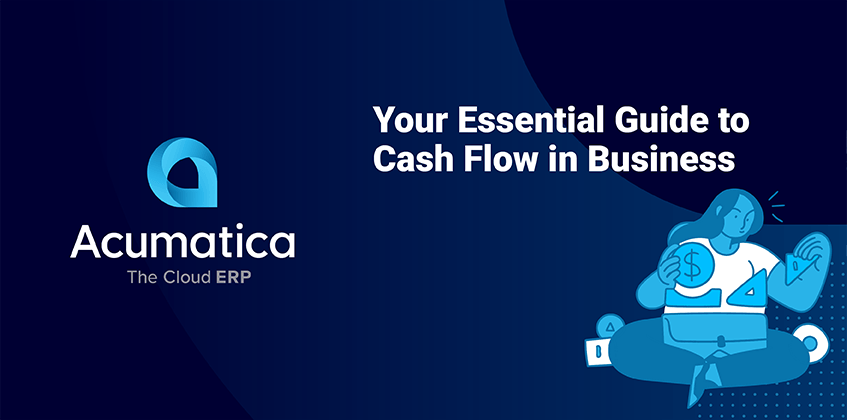
In this article:
Cash flow is critical to the financial success of every business. Today, we will look at how it affects a company’s financial choices and economic health. We will also give basic information and clear advice on how to manage it.
What is Cash Flow?
Cash flow in business represents the total cash inflows and outflows – the movement of money entering the business (cash inflows) and leaving it (cash outflows).
Every business, regardless of size, must track where the money it receives comes from and how that money is being used over time. This information is prepared and presented in monthly or quarterly cash flow reports and in annual cash flow statements.
But don’t confuse cash flow with revenue and income. Revenue is the total amount of money a business takes in from selling products or services. It doesn’t take expenses into account. Income is the amount of earnings left over when expenses are deducted from revenue.
The Main Purpose of Cash Flow
For businesses to make a profit, they need to understand their earnings and expenses. They must ensure that more money comes in than goes out. Understanding cash inflows and cash outflows helps businesses, investors, and creditors see their financial health. It shows if they can:
- Pay short- and long-term debt.
- Reinvest in the business.
- Compensate shareholders.
- Cover all operating expenses (e.g., suppliers, employees, rent, etc.).
- Allocate funds for potential future financial needs.
Types of Cash Flow: Understanding Business Cash Inflows and Outflows
Cash flow comes from three main sources: operations, investments, and financing.
1. Cash Flow from Operations
This is the money used to make goods, like inventory, materials, and labor. It also includes the cash earned from selling those goods. This flow shows if a business can keep or grow its operations. It also helps leaders see if they need outside funding.
2. Cash Flow from Investments
This is the money spent on and earned from different business investments. These include investments in physical assets, securities like stocks and bonds, and research and development (R&D).
3. Cash Flow from Financing
This is the cash used to fund a business, including debt, equity, and dividend transactions. Businesses share their debt-to-equity ratio with investors. Investors value the companies’ current and future profits.
Businesses can calculate each type of cash flow (see next section) and use that data to make crucial operational and financial decisions.
For example, let’s say a single restaurant wants to become a chain. Before they can open another restaurant, the leadership team must know how much cash the current restaurant makes. This includes cash from operations, investments, and financing. This will show them whether they have enough money to cover the initial and future expansion costs.
Calculating Cash Flow
According to NerdWallet, you can calculate net cash flow by following a simple formula:
Total Cash Inflow – Total Cash Outflow = Net Cash Flow
Here’s the breakdown:
- Choose the period of time you want to calculate for—a specific month, quarter, etc.
- Determine the total amount of cash in your business accounts. This is your opening balance.
- Add up your inflows for the chosen period. This includes any money that has come into your business from cash sales transactions, sales of assets, loans, transfers, etc.
- Add the inflows to the opening balance. This will give you your total cash inflow.
- Add up your outflows for the chosen period. This includes any money that has left your business, like payments for operational, investment, and financial expenses (inventory, salaries, overhead, taxes, loans, and bills). This will give you your total cash outflow.
- Subtract the total cash outflow from the total cash inflow. This will give you your net cash flow
But measuring the financial health of your business requires knowing more than just net flow (NCF). You should also calculate operating cash flow (OCF), cash flow from investing (CFI), and cash flow from financing activities (CFF). American Express provides good formulas for making these calculations:
Operating Cash Flow
OCF shows how your company generates cash from its daily operations.
Net Income + Non-Cash Expenses – Change in Working Capital = Operating Cash Flow
Cash Flow from Investing
CFI shows how your company is allocating money for long-term benefits.
Purchase/Sale of Property and Equipment + Purchase/Sale of Other Businesses + Purchase/Sale of Marketable Securities = Cash Flow from Investing
Cash Flow from Financing Activities
CFF shows how much funding your business is generating over time.
Cash Inflows from Issuing Equity or Debt – (Dividends Paid + Repurchase of Debt and Equity) = Cash Flow from Financing
The Basics of Creating a Cash Flow Statement
Since 1988, the Financial Accounting Standards Board (FASB) has required US businesses to make cash flow statements regularly. These statements summarize the inflows and outflows of a business’s cash transactions.
They show businesses how much money they earn and spend. They also track changes in cash transactions. Additionally, they display asset availability over a certain time period.
This information, along with data from income statements and balance sheets, helps assess a business’s liquidity. It also helps evaluate its long-term solvency. Income statements show profitability, while balance sheets show total assets and liabilities.
To create a CF statement, a business must choose between two methods: direct or indirect. The job site Indeed explains the direct method.
This method looks at all cash coming in and going out. It includes cash from customers, payments to suppliers and employees, and taxes and interest paid. The indirect method uses accrual accounting. It includes revenue and expenses when a transaction happens, not when payments are made.
Now, it’s time to calculate cash flow from operating, investing, and financing activities. Use the formulas from the previous section.
The CF statement has three sections: operations, investments, financing.
If gathering financial information, calculating cash flow, and making a CF statement seem hard, you are not alone. These tasks can be tough and take a lot of time. However, businesses can make it easier by using modern CF software. These tools provide strong management features and automate CF tasks.
Software Solutions for Cash Flow and Cash Flow Forecasting
Cash flow software within a comprehensive ERP (Enterprise Resource Planning) solution offers businesses a single tool with cash management features to help users manage day-to-day transactions, track cash balances, handle funds transfers, and manage bank account reconciliations in one place—and do so in real-time.
With the right ERP solution, businesses can automate cash flow management. They can also simplify bank reconciliation processes.
This solution integrates with all financial modules, like General Ledger, Accounts Payable, and Accounts Receivable. It can also meet tax requirements.
An ERP solution can create custom reports. These reports help balance cash accounts and manage short-term cash reserves. They also alert businesses to potential problems.
ERP software helps with cash flow forecasting. It allows businesses to predict future cash needs using detailed transaction data. If the system is cloud-based, it also offers account security. This is done through access control to cash account information and balances.
Conclusion
To succeed in today’s turbulent economy, businesses must effectively manage their cash flow. Accurate and easy-to-create cash flow statements—along with income statements and balance sheets—will clearly show how much money is going into and out of your company, equipping you with the data you need to make wise financial decisions for today and for the future.
With Acumatica, businesses can rest assured that our cloud-based platform and seamlessly integrated Financial Management Suite and Cash Management System offer the features, reporting, and functionality to manage all of their cash flow needs. And their financial data—which resides in a single application—is available at any time and from anywhere.
Says Acumatica customer Ka Man Chan, Chief Financial Officer, Key Code Media, “Now we can see everything in Acumatica instantly. We can look at one unified ecosystem and understand where we are instantly. It’s wonderful.”
Interested in learning more or sharing your insights?
Join the Discussion on Cash Flow in our community forums!
or
 Canada (English)
Canada (English)
 Columbia
Columbia
 Caribbean and Puerto Rico
Caribbean and Puerto Rico
 Ecuador
Ecuador
 India
India
 Indonesia
Indonesia
 Ireland
Ireland
 Malasya
Malasya
 Mexico
Mexico
 Panama
Panama
 Peru
Peru
 Philippines
Philippines
 Singapore
Singapore
 South Africa
South Africa
 Sri-Lanka
Sri-Lanka
 Thailand
Thailand
 United Kingdom
United Kingdom
 United States
United States







